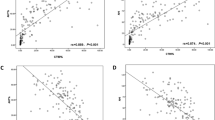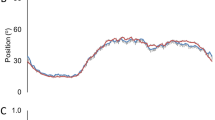Abstract
OBJECTIVE: Several obese subjects show a wide array of respiratory disturbances during sleep due to an increased upper-airway resistance. The aim of the present study was to evaluate diurnal PaCO2 tension in nonsmoking obese women and the possible relationship of this parameter with the presence of sleep disordered breathing (SDB).
DESIGN: Cross-sectional study of PaCO2 tension in obese women.
PATIENTS AND METHODS: A total of 91 nonsmoking obese women (BMI ≥30 kg/m2, aged 42.8±15.7 y) were recruited and evaluated for general and anthropometric parameters, respiratory function, sleep-related symptoms, and sleep disorders of breathing.
RESULTS: A total of 10 subjects (10.9%) had diurnal hypercapnia (PaCO2≥43 mmHg). Age, BMI, neck circumference, apnoea/hypopnoea index, and nocturnal desaturation (expressed as ; =percentage of total sleep time with oxyhaemoglobin saturation <90%) were significantly higher in obese patients with diurnal hypercapnia, compared to normocapnic women. Moreover, hypercapnic patients had reduced forced expiratory volume in 1 s compared to normocapnic individuals. By using multiple regression analysis, the best fitting model (r=0.62, P<0.001) for predicting diurnal PaCO2 tension in the study population showed that 24.23% of the variance may be explained by , according to the equation: PaCO2=0.09 age+0.07 +33.00.
CONCLUSIONS: This study suggests that severity of SDB is the most important factor in determining diurnal PaCO2 tension in apparently healthy nonsmoking obese women.
This is a preview of subscription content, access via your institution
Access options
Subscribe to this journal
Receive 12 print issues and online access
$259.00 per year
only $21.58 per issue
Buy this article
- Purchase on Springer Link
- Instant access to full article PDF
Prices may be subject to local taxes which are calculated during checkout
Similar content being viewed by others
References
Ray CS, Sue DY, Bray G, Hansen JE, Wasserman K . Effects of obesity on respiratory function. Am Rev Respir Dis 1983; 128: 501–506.
Weiner P, Waizman J, Weiner M, Rabner M, Magadle R, Zamir D . Influence of excessive weight loss after gastroplasty for morbid obesity on respiratory muscle performance. Thorax 1998; 53: 39–42.
Holley HS, Milic-Emili J, Backlake MR, Bates DV . Regional distribution of pulmonary ventilation and perfusion in obesity. J Clin Invest 1967; 46: 475–481.
Auchincloss HJ, Cook E, Renzetti AD . Clinical and physiological aspects of a case of obesity, polycythemia and alveolar hypoventilation. J Clin Invest 1995; 35: 1537–1542.
Rapoport DM, Sorkin B, Garay SM, Goldring RM . Reversal of the ‘pickwickian syndrome’ by long-term use of nocturnal nasal-airway pressure. N Engl J Med 1982; 307: 931–933.
Sullivan CE, Berthon Jones M, Issa FG . Remission of severe obesity–hypoventilation syndrome after short-term treatment during sleep with nasal continuous positive airway pressure. Am Rev Respir Dis 1983; 128: 177–181.
Sahebjami H, Gartside PS . Pulmonary function in obese subjects with a normal FEV1/FVC ratio. Chest 1996; 110: 1425–1429.
Resta O, Foschino-Barbaro MP, Legari G, Talamo S, Bonfitto P, Palumbo A, Minenna A, Giorgino R, De Pergola G . Sleep-related breathing disorders, loud snoring and excessive daytime sleepiness in obese subjects. Int J Obes Relat Metab Disord 2001; 25: 669–675.
Berger KI, Ayappa I, Chatr-Amontri B, Marfatia A, Sorkin IB, Rapoport DM, Goldring RM . Obesity hypoventilation syndrome as a spectrum of respiratory disturbances during sleep. Chest 2001; 120: 1231–1238.
Lohman TG, Roche AF, Martorell R . Anthropometric standardization reference manual. Human Kinetics: Champaign; 1991.
Viljanen AA, Halttunen PK, Kreus KE, Viljanen BC . Spirometric studies in non-smoking, healthy adults. Scand J Lab Invest 1982; 42: 5–20.
Laaban JP, Orvoen-Frija E, Cassuto D, Pascal S, Leger D, Basdevant A, Rochemaure J, Guy-Grand B . Mecanismes de l'hypercanie diurne dans le syndrome d'apnees du sommeil associe a une obesitè massive. Presse Med 1996; 25: 12–16.
Kump K, Whalen C, Tishler PV, Browner I, Ferrette V, Strohl KP, Rosenberg C, Redline S . Assessment of the validity and utility of a Sleep-Symptom Questionnaire. Am J Respir Crit Care Med 1994; 150: 735–741.
Johns MW . Rethinking the assesment of sleepiness. Sleep Med Rev 1998; 2: 3–15.
Sleep-related breathing disorders in adults: recommendations for syndrome definition and measurement techniques in clinical research. The Report of an American Academy of Sleep Medicine Task Force. Sleep 1999; 22: 667–689.
Rechtschaffen A, Kales A . A manual of standardised terminology, techniques and scoring system for sleep stages of human subjects. NIH Publication no. 204. US Government Printing Office: Washington, DC; 1968.
Burwell CS, Robin ED, Whaley RD . Extreme obesity associated with alveolar hypoventilation: a pickwickian syndrome. Am J Med 1956; 21: 811–818.
Kessler R, Chaouat A, Schinkewitch P, Faller M, Casel S, Krieger J, Weitzenblum E . The obesity–hypoventilation syndrome revisited. Chest 2001; 120: 369–376.
Vgontzas AN, Papanicolaou DA, Bixler EO, Hopper K, Lotsikas A, Lin HM, Kales A, Chrousos GP . Sleep apnea and daytime sleepiness and fatigue: relation to visceral obesity, insulin resistance, and hypercytokinemia. J Clin Endocrinol Metab 2000; 85: 1151–1158.
Fried SK, Bunkin DA, Greenberg AS . Omental and subcutaneous adipose tissues of obese subjects release interleukin-6. J Clin Endocrinol Metab 1998; 83: 847–850.
Vgontzas AN, Papanicolaou DA, Bixler EO, Kales A, Tyson K, Chrousos GP . Elevation of plasma cytokines in disorders of excessive daytime sleepiness: role of sleep disturbance and obesity. J Clin Endocrinol Metab 1997; 82: 1313–1316.
Collins LC, Hoberty PD, Walker JF, Fletcher EC, Peiris AN . The effect of body fat distribution on pulmonary function tests. Chest 1995; 107: 1298–1302.
Largerstrand L, Rossner S . Effects of weight loss on pulmonary function in obese men with obstructive sleep apnoea syndrome. J Intern Med 1993; 234: 245–247.
Hakala K, Mustajoki P, Aittomaki J, Sovijarvi AR . Effect of weight loss and body position on pulmonary function and gas exchange abnormalities in morbid obesity. Int J Obes Relat Metab Disord 1995; 19: 343–346.
Zwillich CW, Sutton FD, Pierson DJ . Decreased hypoxic ventilatory drive in the obesity–hypoventilation syndrome. Am J Med 1975; 59: 343–348.
Lopata M, Onal E . Mass loading, sleep apnea and the pathogenesis of obesity hypoventilation. Am Rev Respir Dis 1982; 126: 640–645.
Vgontzas AN, Tan TL, Bixler EO, Martin LF, Shubert D, Kales A . Sleep apnea and sleep disruption in obese patients. Arch Intern Med 1994; 154: 1705–1711.
O'Donnell CP, Tankersley CG, Polotsky VP, Schwartz AR, Smith PL . Leptin, obesity and respiratory function. Respir Phys 2000; 119: 163–170.
O'Donnell CP, Schaub CD, Haines AS, Berkowitz DE, Tankersley CG, Schwartz AR, Smith PL . Leptin prevents respiratory depression in obesity. Am J Respir Crit Care Med 1999; 159: 1477–1484.
Phipps PR, Starritt E, Caterson I, Grunstein RR . Association of serum leptin with hypoventilation in human obesity. Thorax 2002; 57: 75–76.
Polotsky VY, Wilson JA, Haines AS, Scharf MT, Soutiere SE, Tankersley CG, Smith PL, Schwartz AR, O'Donnell CP . The impact of insulin-dependent diabetes on ventilatory control in the mouse. Am J Respir Care 2001; 163: 624–632.
Author information
Authors and Affiliations
Corresponding author
Rights and permissions
About this article
Cite this article
Resta, O., Foschino Barbaro, M., Carpagnano, G. et al. Diurnal PaCO2 tension in obese women: relationship with sleep disordered breathing. Int J Obes 27, 1453–1458 (2003). https://doi.org/10.1038/sj.ijo.0802429
Received:
Revised:
Accepted:
Published:
Issue Date:
DOI: https://doi.org/10.1038/sj.ijo.0802429
Keywords
This article is cited by
-
Sindrome delle apnee notturne nelle malattie endocrino-metaboliche
L'Endocrinologo (2006)



